Journal of Agriculture, Food Systems, and Community Development
Journal of Agriculture, Food Systems, and Community Development
Journal of Agriculture, Food Systems, and Community Development
You also want an ePaper? Increase the reach of your titles
YUMPU automatically turns print PDFs into web optimized ePapers that Google loves.
<strong>Journal</strong> <strong>of</strong> <strong>Agriculture</strong>, <strong>Food</strong> <strong>Systems</strong>, <strong>and</strong> <strong>Community</strong> <strong>Development</strong><br />
ISSN: 2152-0801 online<br />
www.AgDev<strong>Journal</strong>.com<br />
agricultural l<strong>and</strong> had been transferred (Greenberg,<br />
2010, p.4); the overall target to transfer 30 percent<br />
<strong>of</strong> agricultural l<strong>and</strong> by 2014 was shifted to 2025.<br />
L<strong>and</strong> reform has been criticized for a number <strong>of</strong><br />
issues, such as poor support for emerging new<br />
farm owners after transfer settlements have been<br />
finalized; lack <strong>of</strong> government coordination between<br />
different spheres (e.g., entitlements, education,<br />
agricultural policies, <strong>and</strong> l<strong>and</strong> reform) <strong>and</strong> scales<br />
(e.g., national <strong>and</strong> local); <strong>and</strong> failure to integrate<br />
l<strong>and</strong> reform within broader rural development,<br />
limiting its potential to promote social equity <strong>and</strong><br />
revive rural economies (Lahiff, 2008b). While<br />
recent efforts to revise l<strong>and</strong> reform <strong>and</strong> agricultural<br />
policies place a renewed focus on a smallholder<br />
strategy, according to Greenberg (2010, pp. 41–42),<br />
the challenge <strong>of</strong> building a more racially inclusive<br />
<strong>and</strong> equitable agricultural model has to confront<br />
the existing economic power <strong>of</strong> commercial<br />
agriculture <strong>and</strong> agro-industry with the aim <strong>of</strong><br />
transforming it. This requires various strategies,<br />
such as de-concentration, decentralization <strong>of</strong> valueadding<br />
activities, <strong>and</strong> the stimulation <strong>of</strong> local<br />
markets, based on the initiative <strong>and</strong> activities <strong>of</strong> the<br />
producers themselves. Part <strong>of</strong> this effort must<br />
include addressing rural women’s <strong>and</strong> men’s<br />
dignity, l<strong>and</strong> tenure, personal security, <strong>and</strong> human<br />
rights overall.<br />
Women, Smallholder Farming, <strong>and</strong> Livelihoods<br />
Although women have been called the key to<br />
household food security (<strong>Food</strong> <strong>and</strong> <strong>Agriculture</strong><br />
Organization <strong>of</strong> the United Nations [FAO], 2011;<br />
International <strong>Food</strong> Policy Research Institute<br />
([IFPRI], 2005; Kent, 2002; Quisumbing, Haddad<br />
& Pena, 1995; Quisumbing & Smith, 2007), gender<br />
is not yet adequately addressed <strong>and</strong> integrated into<br />
discussions on how to achieve adequate food<br />
supplies. Female farmers in all regions have less<br />
access to l<strong>and</strong> <strong>and</strong> livestock <strong>and</strong> less access to<br />
agricultural inputs, credit, education, extension, <strong>and</strong><br />
other services than do men, due to social norms<br />
(FAO, 2011). Further, paid farm labor for women<br />
is <strong>of</strong>ten limited to part-time <strong>and</strong> seasonal work, <strong>and</strong><br />
their wages are characteristically lower than those<br />
<strong>of</strong> men (FAO 2011; cf. World Bank, FAO,<br />
International Fund for <strong>Agriculture</strong> <strong>Development</strong><br />
[IFAD], 2009). According to the FAO (2011),<br />
women in sub-Saharan Africa have the highest<br />
average agricultural labor-force participation rates<br />
in the world, exceeding 60 percent. 3 In South<br />
Africa women represent 61 percent <strong>of</strong> people<br />
involved in farming, <strong>and</strong> they produce more food<br />
for household consumption than men do (Altman<br />
et al., 2009). Despite their crucial role in providing<br />
household food security, <strong>and</strong> despite the comprehensive<br />
inclusion <strong>of</strong> women’s rights in the South<br />
African constitution, women face severe discrimination,<br />
with perpetuating social structures such as<br />
patriarchy <strong>and</strong> paternalism reinforcing their<br />
disempowered position within the household <strong>and</strong><br />
community (Reddy & Moletsane, 2009). In the<br />
context <strong>of</strong> large-scale commercial agriculture,<br />
employment <strong>and</strong> housing contracts on farms are<br />
mostly linked to men. This results in:<br />
• women having no formal housing contract<br />
<strong>and</strong> depending on their male partner for<br />
accommodations;<br />
• impacting resource allocation within the<br />
household, which contributes to women’s<br />
limited decision-making power; <strong>and</strong><br />
• dependency on male partners <strong>and</strong><br />
livelihood insecurity for female farm<br />
workers should the men leave the farm or<br />
stop working (Lemke, Bellows, &<br />
Heumann, 2009).<br />
The FAO’s The State <strong>of</strong> <strong>Food</strong> <strong>and</strong> <strong>Agriculture</strong><br />
2010–11 reiterates the call for policy interventions<br />
that close the gender gap in agriculture <strong>and</strong> rural<br />
labor markets by: (1) eliminating discrimination<br />
against women with regard to access to resources;<br />
(2) creating enabling infrastructure <strong>and</strong> technologies<br />
to provide women with more time for productive<br />
activities; <strong>and</strong> (3) facilitating women’s<br />
participation in flexible, efficient, <strong>and</strong> fair rural<br />
labor markets (FAO, 2011, pp. 5–6). To this end,<br />
we recommend the Sustainable Livelihoods<br />
Approach as an analysis. It can serve not only to<br />
3 The agricultural labor force includes people who are working<br />
or looking for work in formal or informal jobs <strong>and</strong> in paid or<br />
unpaid employment in agriculture. This includes self-employed<br />
women as well as women working on family farms (FAO,<br />
2011, p. 7).<br />
28 Volume 3, Issue 1 / Fall 2012






